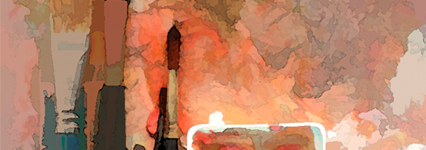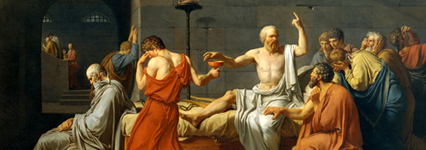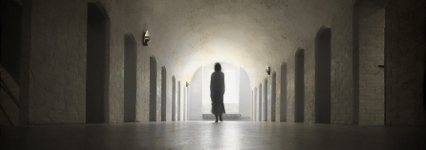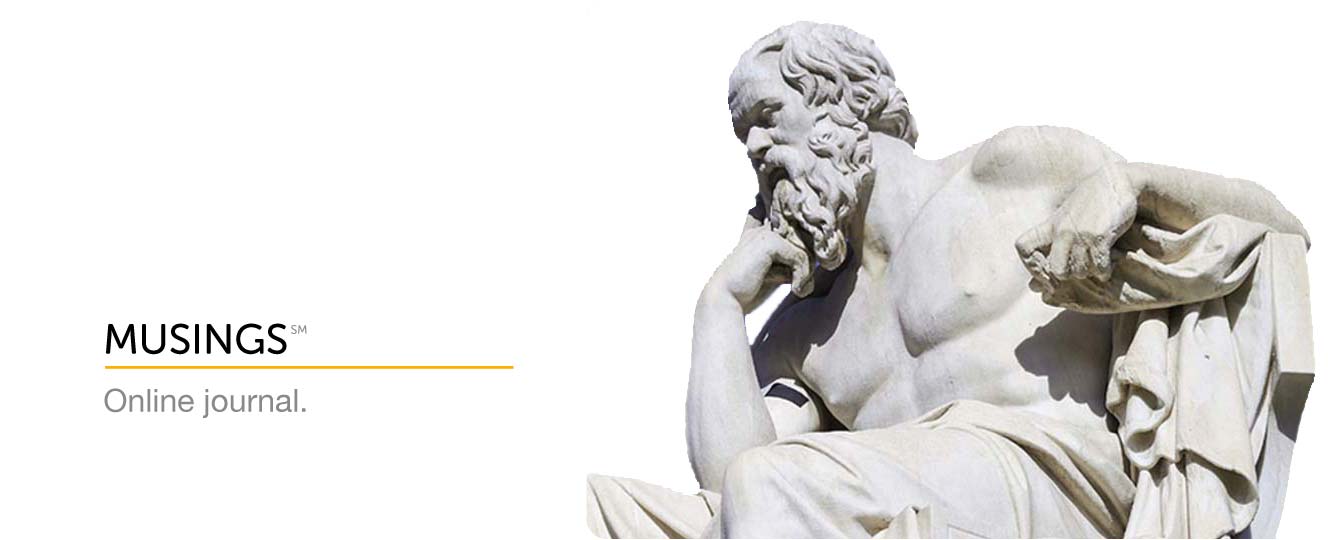What Am I Adding to the Canvas?

As a philosophical counselor, I often speak with clients who are immersed in an issue that has left them raw with pain and struggling for resolution to a point past exhaustion. At such times, I’m reminded that a problem can’t be solved at the same level that produced the problem. Invariably, what these clients need is a paradigm shift, a new and liberating way of looking at the situation that has them stuck fast, and the history of the sort of work we do offers many examples of brilliant facilitators who were able to evoke a realization or “reframing” that allowed the client to shift from contradiction and constriction to realization and release. Milton Erikson, Carl Jung, and Viktor Frankl are three that come to mind. I’ve spent a great deal of time pondering ways that such a shift can be effected. No method works for everyone, of course. Philosophical counseling demands that the counselor remain mindful, alert, and intuitively open to the requirements of the client, the timing, and the situation at hand, and no formula can cover the endless diversity of variables.
One thing I’ve discovered that can help a client out of immersion and at least open the way toward the liberating paradigm shift is to step back from the conflicts with which he or she has been struggling and regard the situation as a painting that all of those involved are creating together. From this new angle of vision, right and wrong or true and false tend to fall away as the standard of the good, and the beautiful is allowed to come forward. It is a thoroughly Platonic approach, one that demonstrates how relevant and powerful Plato’s work still is today. The client, then, rather than thrashing about in the self-repeating details of an inadequate paradigm, tossed on waves of self-doubt and speculation, gets to ask a different sort of question: What am I adding to the canvas? The idea here is to add something good and beautiful, to assess one’s participation aesthetically by holding one’s choices up to whatever standard—generosity, nobility, compassion, detachment, serenity, kindness, etc.—speaks to the client as the most meaningful and humanly beautiful.
Here’s an example: Imagine two people in conflict. Each is convinced that he or she is right and the other wrong. Their perceptions, interpretations, assumptions, and conclusions are locked in a fight to the death. When such situations arise, it usually involves two people who care deeply about each other, such as romantic partners, family members, or close friends, since only two people who care deeply about each other will earn each other’s rancor. Rather than trying to solve (or resolve) the problem at the level that produced the problem, we ask these individuals to consider what they are adding to the canvas of their experience. Are they painting in the dark and depressing colors of blame and recrimination? If so, is this what they want to add? What might they add instead? What happens if they take a moment to recognize and take to heart each other’s pain, grant that something humanly valid is motivating the other, whatever it might be, perhaps even something long unresolved that has little to do with the seductive and intransigent context in which they are immersed, and put down their swords?
There is a story about an African tribe that deals in the most remarkable way with those who violate the social order. Instead of putting them on trial to determine a fitting punishment, they bring the perpetrator before the whole village. One by one, the villagers recount experiences they have had in which the one “on trial” behaved in a way that was heroic or selfless or merciful or noble or wise. Instead of retribution, they invite recollection of all that is good and beautiful and worthy. That is what they add to the social canvas. The effect, as you might imagine, is profound, for never is the good in us called forth and quickened more powerfully than when it is recognized and appreciated by those we love.
The resolve to honor the beautiful lifts us up, out of immersion and into the clear air of inspired thinking and acting. Note that such resolve is completely consistent with self-respect and self-care. Allowing that even the thief running in the night has his story and his reasons in no way obligates us to associate with thieves. We can extend compassion and forgive trespasses from a safe distance, and in this regard, I do not see much value in testing ourselves. There is no question, however, that remembering to ask, “What am I adding to the canvas?” and assessing our choices against the standard of beauty and goodness rather than right and wrong, can elevate us to the realm of truth that sets us free.
28 February, 2016
The Obstacle Is the Path

Various spiritual traditions extol nonresistance as a path for living. Jesus admonished his followers to “resist not evil.” Five hundred years earlier, in the Tao Te Ching, Lao Tze declared, “Because the sage does not contend, no one can contend against him.” Gandhi turned nonresistance into a political movement that freed India from colonial rule. Yet there may be no general spiritual doctrine that is more misunderstood. For many, the word, nonresistance, implies passivity. A student of Florence Scovel Shinn, for example, hearing her teacher espousing nonresistance, expressed the worry that if she took this path, she would be a “doormat,” that everyone would walk all over her. Shinn replied that if she truly practiced nonresistance, she could never be a doormat. Perhaps Shinn was saying that there are certain natural assertions of our being that we would have to resist to allow people to “walk all over” us. In other words living passively involves resistance. If we truly adopted a nonresistant stance, these natural assertions would have a clear channel. We’d express them honestly, because there would be nothing in our psyche blocking that expression. We would say yes when it’s yes, and no when it’s no. The only thing lacking might be the aggressive posturing that we may feel we need to add to whatever we have to say in those cases where we don’t have our own permission to say it. But without self-resistance, there would be no need to “protest too much.” The practice of nonresistance proves that bowing to our own nature never makes us weak. On the contrary, it is the source of our true strength.
The same holds true when the obstacle presents itself in the world. In the Field Project Course, which I wrote from 1993-1997, I put it this way: “The problem and the solution are the same thing. Resist one, and you resist the other.” This is a far-reaching idea that quickly takes on the force of a revelation if one puts it into practice. As it turns out, the only real problem in any situation is resistance itself. If we resist something in our experience, that thing shows up as a problem. The moment we accept it, we step through a different door, and the problem becomes instruction, direction, guidance, illumination—in other words, it becomes a solution. Then we may see that the thing we were resisting was trying to help us all along; it just needed our cooperation. As Buddhism puts it, “Embrace your thousand angels, embrace your thousand demons.”
The Zen saying, “The obstacle is the path,” expresses the same idea nicely. For those committed to self-work and the ongoing improvement of their consciousness, there really are no obstacles, only instruction awaiting recognition. Nonresistance is not a skill one acquires overnight, perhaps, but it is well worth practicing. The path bends around each so-called obstacle and is shaped and determined by it, so that seen from above, as it were, the obstacle and the path are inseparable. If everything that we used to think was frustrating us, impeding our progress, or derailing our plans turned out to be nothing more than the path winding in an unexpected direction and calling us to take it, how effortless our life would become! How quickly our problems would reveal themselves as solutions, and our demons, unmasked, would be seen at last as angels we had been unwilling to embrace.
21 January, 2016
The Wisdom of Ignorance

The more I live, the less I know, or perhaps the more I know how little I know. But this “ignorance” is strange, because historically, ignorance suggests darkness, as in, for example, the Dark Ages, and knowledge is associated with light, as in, for example, the Age of Enlightenment, yet I’ve found that my ignorance gives off a light, and that this light reveals a spaciousness in which things can stand forth and be seen for what they are, here and now, in the uncluttered present.
This has proved highly instructional, more so than any university course or program of study I ever undertook. No one in all of history has been a better student or teacher of this wise ignorance than Socrates, who spent his life in what proved to be a futile attempt to disprove a statement uttered by the Delphic Oracle, which, when asked by Chaerephon, Socrates’s friend, if anyone was wiser than Socrates, declared that Socrates was the wisest. Learning of this, Socrates was puzzled, since he knew that he possessed no wisdom, and so he set out on a lifelong mission to find someone who was wiser than he, with the idea that he would take this person back to the Oracle as irrefutable proof of the error of its pronouncement. Things, however, didn’t go as he’d planned, since everyone he engaged in dialogue who claimed to know this or that, to be wise in this sense, turned out not to know at all. One by one, as reported in Plato’s Dialogues, Socrates’s interlocutors, having been bested by his relentless philosophical and rhetorical virtuosity, took their leave of the conversation disabused of false notions. It began to dawn on Socrates that, while he knew nothing, he also knew he knew nothing, while other men, knowing nothing, believed they knew, and that therefore, he was, by that slight measure, wiser than they. The Delphic Oracle, it turned out, was spot on.
Today, the wisdom of the old Greek is needed more than ever. My counseling clients often get stalled on an unexamined assumption or false conclusion that has sent them racing, sometimes with great conviction and passion, in an unhelpful direction. They want to know what to do next, how to resolve this or that problem, but in a way, knowing is the problem—or at least thinking they know something they really don’t know at all. If they can come to see that they’re at a loss, a space opens where something new can show itself. The situation that led them to schedule a counseling session may seem daunting, overwhelming, even hopeless—yet often all that’s needed is to expose the imposter that has taken them hostage. It’s a great relief to put down the burden of false knowledge, and this is something that philosophical counseling is designed expressly to do. It takes away our misguided conclusions, and in this subtraction, creates an opening where before there was only constriction. In a manner of speaking, it exposes the most fortunate sort of ignorance, and in so doing, leaves us that much wiser and better off.
30 November, 2015
Ghosts
From ghoulies and ghosties
and long-leggedy beasties
and things that go bump in the night,
good Lord, deliver us!
| Old Scottish prayer

We humans seem to have an unrelenting fascination with ghosts—personalities without bodies famous for haunting unfortunate houses and bringing varying degrees of trouble from mischief to malevolence. Whether there are in fact such things, I can’t say. It wouldn’t surprise me if there were, but such mysteries are beyond my reach. Whether personalities can exist apart from their mortal wrappings is one that I’m happy to leave to those with more of a penchant for the paranormal. There is, however, another sort of ghost—the kind that has no body but has a will, that stirs the waters of misfortune trouble wherever it turns up, that haunts and possesses humans and generally makes life miserable for us. I’m talking here about aspects of our own psyche, divergent streams of consciousness and identity that seem to have the sole purpose of working against us and getting us to work against ourselves, tripping us up, provoking us to destructive choices, and sowing the seeds of disorder and chaos.
I encounter these spirits in counseling sessions all the time. They may make their appearance in the middle of a client’s sentence, such that the man or woman who starts the sentence is not the one who finishes it. It is very much as though the ghost takes possession of the client’s vocal chords and waylays the conversation, pitching it back toward some impacted repetition that has never served the client well, but which he or she, for some reason, is unwilling to release. The effect, of course, is never as dramatic as we see in Hollywood depictions, with heads spinning around, bodies flying across the room, or normal voices becoming suddenly cavernous and charged with something alien and evil. It is far subtler, so that if I point out the change to the client, and ask who finished the sentence, often the client is startled, then baffled. The very real ghosts I’ve seen, the ones that haunt the attics and basements of the psyche, the ones that rattle chains of perfectionism, self-absorption, belligerence, victim-thinking, and denial are routinely mistaken for the self. They hide in our voice, in the face we see in the mirror, in assumptions and identifications so obvious that we might never suspect them, and from these venues, that dark pantheon usurps and torments us.
Fortunately, we mortals have an internal barometer of sorts that can alert us when we slip into a momentary possession, even in mid-sentence. Detecting the drop in pressure depends on, above all else, the willingness to do self-work, to question those things that we have taken so for granted that it would hardly occur to us to question them, and to begin to attend to our inner states with the curiosity and diligence of a good student. That barometric alarm is felt in mood shifts. They may be intense or subtle, but in every case, careful attention will reveal a foreign element. This awareness is the first step in exorcising the ghosts of unexamined assumptions and conclusions, angry or frightened voices we introjected early and have been living in our house without our permission ever since. And this is absolutely saving. It means that we cannot continue to be possessed without our permission. Without this assent, no ghost can enter or stay. Most of the time, the debilitating anger or anxiety with with a client is struggling is not native, not his or her own. Its adaptation, its agenda, its intensities originally belonged to someone else.
There’s an old South African folk tale about a family whose house is plagued by a poltergeist. For months, they put up with slamming doors and cupboards, furniture sliding here and there, and all other manner of annoyance. Finally, able to stand it no longer, they decide to vacate the house. At the end of the story, they’re driving off with all their belongings, and there, sitting in the back of the truck, is the poltergeist, waving as he says, “Bye bye, we’re leaving!”
Clearly, unless we’re willing to do the self-work that expels our ghosts once and for all, we take them with us. It is wise, then, to pay attention to the barometric changes occurring in the inner weather, and to take the time we need to engage anything expressing itself through us that feels unlike us—a suddenly angry overreaction, an atypically harsh judgment of another, a frisson of apprehension over something that does not seem to warrant it, a surge of perfectionism, a jolt of self-doubt. Not every voice in our head is ours. Even those who live alone may have unwanted roommates. Self-knowledge frees us from adverse influences that may have taken up residence in our psyche a long time ago, restoring a sense of peace and order that we hardly may have realized was missing.
31 October, 2015
Life Scripts

The seeds of contradiction are sown early, in “contracts” entered into by parents and their children. Generally, these contracts are written and enforced outside awareness and passed along from one generation to the next through “scripts” internalized and read unconsciously. This idea of scripts comes from a psychological model called “transactional analysis” (often referred to simply as “TA”), a neo-Freudian methodology developed into a therapeutic method by Eric Berne in the 1960s, and presented in his bestseller, Games People Play. TA focuses on social transactions, as these provide a good way to asses the contracts that shape a person’s development. According to TA, the rules for living (permissions and injunctions) are passed along early and will largely determine a person’s life path for good or ill. Among the more maladaptive roles are three identified by Stephen Karpman in something called the “Karpman Drama Triangle,” viz., the Persecutor, the Victim, and the Rescuer. Each represents a scripted identity that leads to suffering and self-defeating behavior as the person “reading” the script moves around the triangle, initiating and responding in a set of interactions driven by an ulterior motive (“games”) to a predictable outcome, and switching from one role to the next as the game requires.
Philosophically, we can understand “games” or stances as ways of being rooted in deep and largely unexamined assumptions about the world and our place in it—in other words, reality and identity. During the early years especially, even before they have acquired language, children are keen observers of what appears to work and what doesn’t. Inwardly, they are “taking notes,” learning, and drawing conclusions. As our very survival depends on our being loved and accepted, parental censure or rejection can be devastating, inflicting deep wounds, and undermining the child’s confidence, which can set the stage for lifelong consequences that undermine emotional, psychological, and spiritual health and well-being. Perhaps caught in their own unresolved life scripts, driven by guilt, blame, or shame, many parents may not realize that what they say to their children, especially repeatedly, has the power to bless or curse them, and to impose upon them self-definitions that are hurtful and destructive. Empathetic, encouraging, nonreactive parents who are mindful and respectful of boundaries and give their child room to grow into selfhood and autonomy bless their children with messages of love, acceptance, and support. Parents who are rigid, on the other hand, who impose their will on their children, do too much for them, withdraw love conditionally, or are abusive in any form may unwittingly curse their children with the messages they send verbally, nonverbally, through modeling, or through the assumptions they harbor about the child. Statements such as, “You’ll never amount to anything,” or “You’re always getting into trouble,” and the like become parental imperatives in a child’s logic. These parents may believe they’re lamenting shortcomings in their child’s character, that they’re trying to correct or even protect their child from whatever dire consequences they fear may come to pass, but in fact, in the depths of the young, receptive psyche, such statements become predictions that the child will work unwittingly but relentlessly to fulfill throughout his or her life, even when the consistent results are suffering and defeat. It’s important to add here that TA goes beyond Freudian “life-predictive” theory in pointing out that the script is based on decisions that the child makes in the attempt to deal with the world. The parent has an enormous, irresistible influence, but the scripts are fundamentally decisional. The reason this is important is that it conserves our ability to rewrite these scripts (or discard them) as adults. We aren’t condemned to live out the childhood script once those formative years are behind us, though sadly, many will.
According to TA, each of us embodies the three ego-states of Parent, Child, and Adult. When adults respond as children in their interactions, they’re reading from a script. Upon being offered a suggestion for improvement from an employer, for example, they may feel blamed. Those who act parentally toward other adults, such as rescuers and enablers, are also displaying “scripty” behavior. The aim of self-work in TA is to strengthen the client’s Adult so the client can be present, making it possible to receive and work with information in a sane and grounded way—and to resolve any “games” that show up when the Adult is “contaminated” by either the Parent or the Child.
At the end of the day, our full individuation as adults can depend on our tearing up the old life contract that we “signed” in childhood. Getting clear enough to recognize, challenge, and ultimately declare the old contract null and void takes some doing. This psychic coming of age is the business of self-work in many models, not just TA, and it isn’t easy. For one thing, the early agreements may be so deeply rooted in our sense of who we are that they can be tough to identify and call out. Once they have been identified, there’s the further matter of the courage to stand up to them, and to begin to replace them with something more in keeping with self-care. Challenging the old ways of being may uncover deep fears and prohibitions designed to protect the payoffs that led us to agree to the contract in the first place. The feeling is not unlike that of standing up to a bully. The soul that has undertaken its liberation from an old script may have to endure a few dark nights—but if we persevere on the path of self-work, calling forth the needed courage and making good use of whatever support is available to us, the rewards are inestimable. Limitations that seemed to dog us through decades finally can fall away, so that we are no longer tyrannized by old agreements that in serving us, also took us hostage.
Philosophical counseling is not TA. Its methods are not Freudian, for one thing. Yet the work is remarkably similar to this down-to-earth approach to resolving long held contradictions, examining root assumptions about identity and reality, reevaluating choices—even those that we’ve been making unwittingly—and discovering the inner resources for clarity, resolution, and healing that reside within each of us. One of the features of TA that made it so popular among eclectic therapists was its friendly, accessible language. It spoke to people where they live, working within the premise that mental health problems are readily observable in social transactions, and that any disorder in consciousness can be treated and remedied through methods that resolve Parent/Child contaminations of the Adult and help the individual to come out of scripts and into the living present. Philosophical counseling, in a similar way, works with the client’s current reality and identify commitments to determine whether they are supporting or hindering his or her ability to be present-in-the-world, which means to live a sane, grounded life free of contradictions, self-combat, ancient overlays, and unfinished emotional business. Where these commitments come from is far less important in philosophical counseling than it is in psychoanalytic sessions. Through philosophical self-work, we can gain self-knowledge and become aware of what’s driving us, what’s bothering us, what’s holding us back, what we’ve been believing, what we’ve been allowing to define us, and this self-knowledge can illuminate whatever next step we need to take to begin living a life without childish scripts and old, obsolete contracts.
Viewed in this light, every problem, no matter how oppressive or intractable it may seem, is an opportunity, a direction waiting to be recognized and taken, a call to self-awareness, and a gift of freedom from old constrictions and compromises that gave us life by taking life from us. TA tells us that the more time we spend “out of script,” the more we loosen the hold of the old contract. Philosophical counseling adds that there is a dialectical element in this sort of self-work, an idea that we may find just as heartening, since it implies that any life-negating script tends to negate itself. This isn’t just theory. I’ve never seen a problem that didn’t contain its own solution. If we will hang in there, reach out for help when we need it, and see the thing through—we can tear up the old contracts, come home to a less sullied self, and at any age, begin again—knowing, perhaps for the first time, how wonderful it can be to be young.
30 September, 2015
Weeding the Yard

I had moved into a new house in March, and by that weekend, somehow, the first prescient breezes of mid-August were stirring the evening air. The list of things to do was growing longer as I checked each one off, and before I knew what was happening, the back yard had been overrun by an army of weeds that now stood a meter tall from fence to fence. An incidental nuisance, barely noticed out of the corner of one’s eye, had emerged from the periphery and accelerated without warning, choking off the everyday corridors and usurping what had been free, open space until the problem seemed all but insurmountable. The sudden awareness of this brought a sense of uneasiness, a worry that there might be other alien forces, hiding in the light of day, preparing to do the same—to advance without warning, to invade, to take over.
The same week that I finally noticed what was going on in the back yard, an article came out in The New York Times exposing the telecom giant AT&T’s “extreme willingness to help” the National Security Agency (NSA) appropriate the emails and phone records of millions of U.S. citizens as part of its mass domestic surveillance program, which began under George W. Bush shortly after 9/11 and has expanded during President Obama’s administration, a program of warrantless search and seizure conducted without reasonable cause or due process in stark violation of Fourth Amendment protections. Verizon, too, had been instructed to turn over the “metadata” of the phone calls of millions of Americans by a FISA court order that had been classified as secret. In 2014, this overreaching collection of data by the NSA on the foreign front had led the German government to cancel its contract with Verizon.
In standing up to abuses of power by government agencies and corporations, there may not be much one can do, but one can do something. The week that The New York Times articles came out, I closed my AT&T account with an email explaining my reason. I was “voting with my wallet” by refusing to patronize a company that colludes in the violation of basic democratic rights. It would be naive, of course, to expect CEOs to refuse to comply with a court order, since doing so would put them at risk of imprisonment. As Voltaire notes, “It is dangerous to be right when the government is wrong.” The needed solution here has to come from Congressional action based on the courage and resolve to protect American constitutional rights even in the age of terrorism. By its actions, however, AT&T had shown that it had no place in my world. It had become a weed, and it had to go.
The back yard of America is no longer one that I recognize. Global companies operate as sovereign nations while government looks the other way. In the years of my youth, the idea of a secret American court issuing secret orders granting the government unchecked authority to violate the privacy of millions of Americans would have been unthinkable, a dystopian fantasy along the lines of George Orwell’s chilling novel, 1984. It is distressing to witness Constitutional guarantees being flouted in the name of national security; to be part of a decimated middle class that has to choose between necessities in the wealthiest nation on the planet; to read headlines of gun violence escalating every day on both sides of the law; to watch in disbelief as Presidential candidates give flippant non-answers to serious questions from the media and are allowed to get away with it; to cling to one’s faith in the democratic process while obstructionist Congressional leaders invoke religion and malign intellect as justifications for hatred and the abrogation of civil liberties; to have to stand by while statesmanship is reduced to demagoguery and pettiness and pandering, to wonder if, at this hour in our national history, anything can be done to clear out the rampant overgrowth of strident ignorance and short-sightedness and posturing.
During U.S. campaign seasons, one notices that every candidate is promising to “fight for” this or that good and just cause, which leaves one wondering why so much fighting for good and just causes is necessary in a nation that never stops touting its greatness. The truth, the confession implicit in these political promises, is that America is no longer what it used to be, not by a long shot, and hasn’t been for some time. The weeds of self-interest, obstructionism, violence, complacency, consumerism, and fear, which have been growing at least since the end of the second World War, have choked off the very way of life that leaders at every level of government are sworn to protect and ensure. Each year, it seems, the weeds take over more of the yard.
This has been gradual, a steady encroachment that accelerated after the horrific events of the morning of 11 September, 2001, when fear surged through the psyche of America and opened the way to a reactive radicalization of the assumptions underlying legitimate national self-interest. An adversarial relationship, legislatively formalized in the so-called Patriot Act was set up between safety and civil liberties. Conservative elements sought to close the loopholes of risk by granting the government unprecedented and unconstitutional powers to intrude on the privacy of American citizens in order to identify potential threats early and move preemptively against them. This is the paradigm within which American political leaders of both parties over the past near decade and a half have made and supported sweeping decisions that authorize the abuse of power in the name of national security. The paradigm, like all paradigms, comes with a price. And where that price requires the violation of clearly stated constitutional rights and protections, it is too high. In such an America, the fight against terrorism has become a kind of terrorism in itself, one at least as dangerous to democratic ideals and values as the more conspicuous sort.
This past week, I managed to get the back yard under control. The weeding is done, for the most part, and the yard is once again spacious and accessible, though I’ve noticed that the work is never done once and for all. Little by little, unnoticeably at first, the weeds return, making it clear that preserving a free and open back yard demands a daily vigilance and the wisdom to deal with problems before they get out of hand. Weeds are, in a sense, single-minded; left to themselves, they would overtake the house and render it unlivable. Having seen what they can do, from now on I mean to keep an eye out the window and tend the yard as soon as it needs tending. What a victory it will be when America, land that I love, does the same.
30 August, 2015

